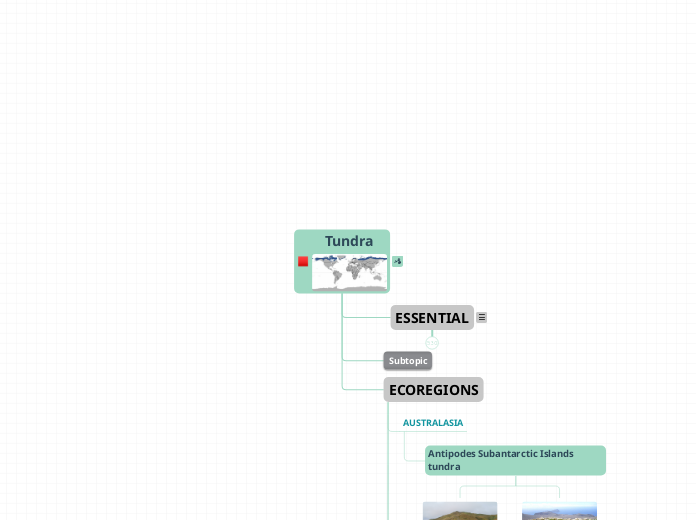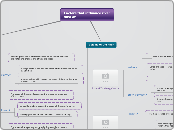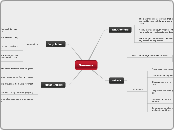Tundra
ECOREGIONS
ANTARCTIC
Transantarctic Mountains tundra
Southern Indian Ocean Islands tundra
South Victoria Land tundra
South Orkney Islands tundra
South Antarctic Peninsula tundra
Scotia Sea Islands tundra
Prince Charles Mountains tundra
Northwest Antarctic Peninsula tundra
Northeast Antarctic Peninsula tundra
North Victoria Land tundra
Marie Byrd Land tundra
Enderby Land tundra
Ellsworth Mountains tundra
Ellsworth Land tundra
East Antarctic tundra
Dronning Maud Land tundra
Central South Antarctic Peninsula tundra
Adelie Land tundra
PALEARCTIC
Yamal-Gydan tundra
Wrangel Island Arctic desert
Trans-Baikal Bald Mountain tundra
Taimyr-Central Siberian tundra
Russian Bering tundra
Russian Arctic desert
Novosibirsk Islands Arctic desert
Northwest Russian-Novaya Zemlya tundra
Northeast Siberian coastal tundra
Kola Peninsula tundra
Kamchatka tundra
Chukchi Peninsula tundra
Cherskii-Kolyma mountain tundra
NEARCTIC
Torngat Mountain tundra
Pacific Coastal Mountain icefields and tundra
Ogilvie-MacKenzie alpine tundra
Kalaallit Nunaat Arctic steppe
Interior Yukon-Alaska alpine tundra
Davis Highlands tundra
Canadian Middle Arctic Tundra
Canadian Low Arctic tundra
Brooks-British Range tundra
Beringia upland tundra
Beringia lowland tundra
Arctic foothills tundra
Arctic coastal tundra
Aleutian Islands tundra
Alaska-St. Elias Range tundra
Ahklun and Kilbuck Upland Tundra
AUSTRALASIA
Antipodes Subantarctic Islands tundra
ESSENTIAL
1. Forest-tundra
2. Dwarf tundra
3. Moss-lichen tundra
4. Arctic tundra
https://www.mindomo.com/mindmap/9d561b3a0eca4e95b62762fdc4f666df
https://pl.wikipedia.org/wiki/Tundra_krzewinkowa
BIOME ESSENTIAL
Canadian High Arctic tundra
Oxyria digyna
Dryas integrifolia
Luzula confusa
Alopecurus alpinus
Pleuropogon sabinei
Dupontia fisheri
Eriophorum angustifolium
Carex aquatilis
Kalaallit Nunaat High Arctic tundra
50% of the territory is bare rock and ice, or very sparse vegetation. 30% of the ecoregion has a cover of moss and lichen, and another 3% of herbaceous cover and shrubs
Some small areas on the east coast have greater plant life around
hot springs, particularly marsh willowherb (Epilobium palustre)) andthe northern green orchid (Platanthera hyperborea)
Studies have identified eight types of vegetation on the east coast from 72 to 79° N:
Dwarf shrub heaths (Cassiope tetragona
, Salix arctica
, Vaccinium uliginosum
or Betula nana
,
Grasslands (dry in summer: Arctagrostis latifolia
, Carex bigelowii
, sooty sedge (Carex misandra
), and Eriophorum triste
)
Permanently wet fens (Carex stans
, Eriophorum scheuchzeri
, and Arctagrostis latifolia)
Snowbeds (Phippsia algida
, Salix herbacea
, Trisetum spicatum
and Erigeron humilis)
;
Open, graminoid Dryas-heaths and fellfields on dry soil (Carex nardina
, Carex rupestris
, and Kobresia myosuroides)
;
Fellfields (Calamagrostis purpurascens
and Carex supina
)
Communities on wet ground that is covered by an organic crust (Koenigia islandica
and Festuca hyperborea
);
Halophytic vegetation (Puccinellia phryganodes
and Carex subspathacea
).
Platanthera hyperborea
Epilobium palustre
Carex (Sedge)
Carex rupestris
Carex nardina
Carex misandra
Carex subspathacea
Trisetum spicatum
Puccinellia phryganodes
Calamagrostis purpurascens
Eriophorum triste
Carex supina
Scandinavian Montane Birch forest and grasslands
Stekenjokk (vildmarksvägen)
Ljungdalsfjällen
Early June
Hardangervidda (Eidfjord)
FLOWERS
GRASS
GROUND
October
September
August
July
June
LICHES
Stereocaulon
Flavocetraria nivalis
Cetraria
Cetraria ericetorum
Cetraria islandica
Cladonia stellaris
Cladonia crispata
Cladonia arbuscula
Sphagnum
Sphagnum squarrosum
Sphagnum girgensohnii
FLOWERS/HERBS
Equisetum fluviatile
arabis alpina
pinguicula vulgaris
Geranium sylvaticum
ranunculus acris
comarum palustre
Maianthemum bifolium
Aconitum lycoctonum
Melampyrum sylvaticum
Arnica angustifolia
Oxalis acetosella
GRASS/SEDGE
Eriophorum brachyantherum
Deschampsia
Deschampsia alpina
Deschampsia flexuosa
Festuca
Festuca ovina
Poa
Poa pratensis
Poa alpina
SHURBS
Salix arbuscula
Salix polaris
Salix caprea
Empentrum
Empetrum hermaphroditum
Pinus pumila
Vaccinium myrtillus
TREES
The treeline forest of these high mountains is the only one in the Northern tundra not to be composed of conifers: it is a tangle of downy birch.
https://www.oneearth.org/ecoregions/scandinavian-montane-birch-forest-and-grasslands/
http://www.diva-portal.org/smash/get/diva2:565333/FULLTEXT01.pdfBengt
DECIDUOUS
Betula pubescens
mossy birch
Prunus padus
Sorbus aucuparia
Alnus incana
Populus tremula
CONIFEROUS
Sometimes much of the lowland forest near the fjords of Western Norway is also included as Norway spruce is mostly absent here (both Norway spruce and Sitka spruce are commonly planted for economic reasons).
Picea
Picea obovata
hybrid Picea × fennica
Pinus sylvestris
TERRAIN
GROUND TYPES / SOIL / ROCK
lakes
Jämtlandsfjällen, Sweden
Abisko, Sweden
Hardangervidda, Norway
Syenite
Schist
Parts of the ecoregion are located in smaller mountain areas surrounded by lower elevation biomes, as is the case with coastal mountains in Norway. At the highest altitude is high alpine tundra with very modest vegetation and bare rock, skree, snowfields and glaciers. At lower altitude is low alpine tundra with continuous plant cover; dwarf birch and willows up to 1 m tall and grasslands, as well as numerous lakes and bogs. At still lower altitude is the adjacent montane birch zone with small (2–5 m) mountain downy birch (Betula pubescens) above the conifer tree line; some stunted spruce and pine, and many lakes and bogs. This part is regarded as part of the High boreal (sparse taiga) vegetation zone; birch forming the treeline is very rare outside Scandinavia (also in Iceland and the Kamtchatka peninsula).
BIOME ESSENTIAL
Tundra
The arctic tundra is located between the north pole and the coniferous forests or taiga region. It is characterized by extremely cold temperatures and land that remains frozen year-round. Arctic tundra occurs in frigid mountaintop regions at very high elevations.
Alpine tundra can be found in high elevations anywhere in the world, even in tropic regions. Although the land is not frozen year-round as in arctic tundra regions, these lands are typically covered in snow for most of the year.
The difference between the Arctic and Alpine tundra is that the soil in the Alpine tundra region is not permanently frosted. Therefore, small shrubs are visible in the Alpine tundra region.
Arctic Tundra:
- North America - Northern Alaska, Canada, Greenland
- Northern Europe - Scandinavia
- Northern Asia - Siberia
Alpine Tundra:
- North America - Alaska, Canada, U.S.A., and Mexico
- Northern Europe - Finland, Norway, Russia, and Sweden
- Asia - Southern Asia (Himalayan Mountains), and Japan (Mt. Fuji)
- Africa - Mt. Kilimanjaro
- South America - Andes Mountains
COMPONENTS
For this biome
most typical and representative species of:
trees
shrubs
grass
mosses
lichens
soil
rocks
other
LICHENS
Nephroma arcticum
Dactylina arctica
Cladonia
Cladonia borealis
Cladonia rangiferina
Rhizocarpon geographicum
MOSSES
Moss will grow in wide and thick clumps, but what looks like a giant plant is actually hundreds of little tiny plants growing closely together. Growing in bundles allows plants to be sheltered from the harsh conditions, so it is an effective adaptation for many plants in the tundra.
Diphasiastrum alpinum
Fissidens adianthoides
Syntrichia ruralis
Hylocomium splendens
Polytrichum strictum
Dicranum scoparium
Racomitrium canescens
Drepanocladus aduncus
Aulacomnium palustre
Calliergon giganteum
Calliergongiganteum
FLOWERS / HERBS
During the summer the wildflowers bloom quickly and beautifully. There are 400 different flowers in the arctic tundra. Most of the flowers that survive in the tundra are perennials; they lay dormant in the cold winters and grow again from the same roots in the summer.
Veronica alpina
Antennaria alpina
Bartsia alpina
Pedicularis flammea
Campanula uniflora
Erigeron humilis
Saxifraga
Saxifraga oppositifolia
Saxifraga paniculata
Saxifraga cespitosa
Gentiana nivalis
Rhododendron tomentosum
Papaver radicatum
Rubus chamaemorus
Silene acaulis
Chamaenerion latifolium
Pulsatilla vulgaris
SOURCE?
GRASS / SEDGE
The ground of the arctic tundra is marshy and boggy during the summer, so plants must be able to survive in water-logged areas. Seasonal grass thrive anywhere there is a little bit of soil and enough water. You will often see clumps of grass growing in marshy areas of the arctic tundra.
Festuca vivipara
Carex
Carex scirpoidea
Carex bigelowii
Carex rufina
Puccinellia vahliana
Phippsia algida
Arctagrostis latifolia
Eriophorum
Eriophorum callitrix
Eriophorum triste
Eriophorum scheuchzeri
Polygonum viviparum
Poa arctica
Alopecurus magellanicus
SHRUBS
Empetrum nigrum
Arctostaphylos alpina
Lonicera caerulea
Salix
Salix arctica
Salix planifolia
Salix lapponum
close to the river
Cassiope tetragona
Vaccinum
vaccinium myrtillus
Vaccinium uliginosum
Vaccinium vitis-idaea
Amelanchier alnifolia
Dasiphora fruticosa
Ribes triste
Arctostaphylos
Dryas octopetala
DWARF TREES
Subtopic
Alnus
Alnus viridis
Alnus alnobetula subsp. fruticosa
Alnus alpina
Betula
Betula nana
Betula humilis
Juniperus communis
Picea obovata
Salix herbacea
LANDSCAPE FEATURES
Grasslands
Lakes
Bogs
Snowfields
Dominant rock
Base-rich rocks, made-up of, for example, phyllites or garnet schists, generally harbour a distinct and species-rich, calcicolous vegetation (Fig. 2). In contrast, the more common, hardweathered acid rocks, such as quartzites, syenites or hard schists, often give rise to a species-poor flora dominated by dwarf shrubs or graminoids with lower nutrient requirements.
Sedimentary rock
Phyllite
Quartzite
Permafrost
Pingo
Ice wedge
High and low center polygons
Frost boil
Thermokarst
GENERAL LOOK
SUMMER
Richardson Mountains
WINTER









